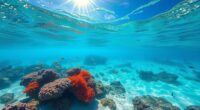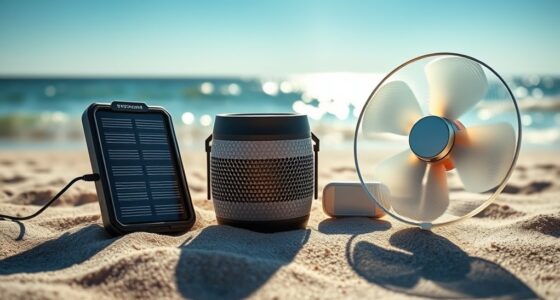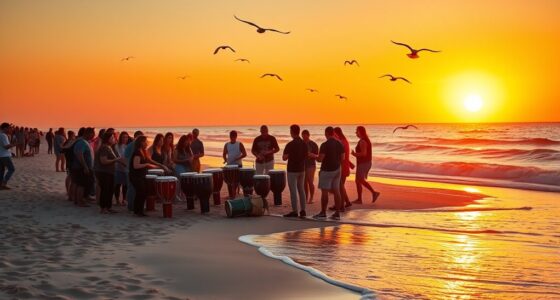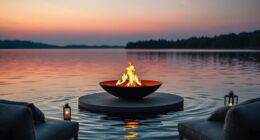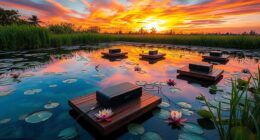As you float along the shoreline, you’ll notice floating marine vegetation like seaweed and plankton, providing food and shelter for young fish and invertebrates. Resilient plants with reflective leaves may drift nearby, helping stabilize the environment. Tiny crabs and insects may be seen scuttling on the surface or bobbing among the plants. These lively elements create a vibrant, dynamic habitat that supports a rich variety of life—discover more about this fascinating ecosystem below.
Key Takeaways
- Floating seaweed, such as kelp or sargassum, provides shelter and food for juvenile fish and invertebrates.
- Tiny plankton and microorganisms drift with the current, forming the base of the marine food chain.
- Some floating plants have reflective surfaces that help reduce water loss and protect against dehydration.
- Seabirds may hunt for fish around floating vegetation, benefiting from the shelter and prey abundance.
- The presence of floating marine vegetation indicates a healthy, productive ecosystem supporting diverse species.
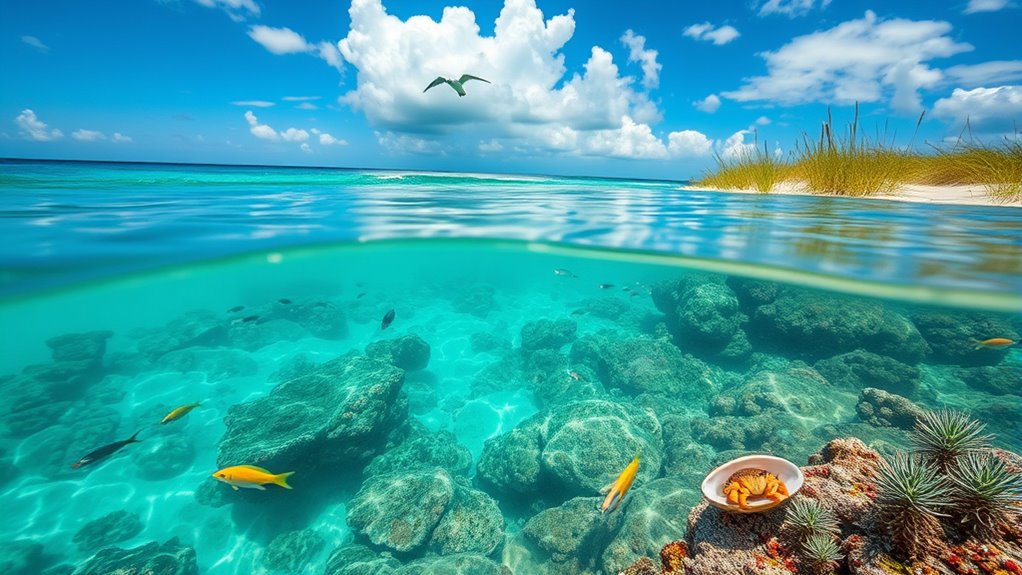
Have you ever wondered what plants and animals thrive along the sandy shores? As you drift gently near the shoreline, you’ll notice a vibrant ecosystem teeming with life. One of the most stunning features you might observe is a coral reef. These underwater structures act like bustling cities for marine creatures, offering shelter and food to countless species. Brightly colored corals create intricate patterns that sway with the current, drawing your gaze downward. Fish dart through the nooks and crannies, while larger predators patrol the perimeter. The coral reef’s delicate balance supports a diverse array of life, making it an essential part of coastal ecosystems. If you’re lucky, you might even see seabird nesting sites nearby. Seabirds often choose sandy or rocky islands close to reefs to lay their eggs, taking advantage of the abundant food sources that thrive around these habitats. From your vantage point, you may notice fluffy chicks peeking out from their nests or adult seabirds swooping low over the water, hunting for fish. These birds play a critical role in maintaining the health of the shoreline environment, controlling fish populations, and contributing to nutrient cycling.
As you float along, you’ll also observe various types of beach flora that have adapted to withstand saltwater and shifting sands. Hardy grasses and low shrubs cling stubbornly to dunes, their roots stabilizing the sand and preventing erosion. Their tough leaves and stems often have a silvery sheen, reflecting the intense sunlight while protecting the plants from dehydration. These plants serve as an indispensable habitat for insects and smaller animals, creating a miniature food web right along the shoreline. You may even spot tiny crabs scuttling across the sand or burrowing beneath it, helping aerate the soil and recycle organic material. Additionally, some of these hardy plants may host beneficial microorganisms that aid in nutrient absorption and resilience against harsh conditions.
Further out, you might notice the occasional floating seaweed drifting on the surface. These marine plants provide food and shelter for juvenile fish and invertebrates. Their presence indicates a healthy, productive environment that supports a wide range of life forms. As you continue to observe, keep in mind that every creature, from the smallest pebble to the largest seabird, plays an essential role in maintaining the balance of this dynamic ecosystem. The shoreline is a living mosaic, constantly in flux, but always indispensable for the survival of countless plants and animals that call it home.
Frequently Asked Questions
Are There Any Dangerous Creatures to Watch Out for While Floating?
Yes, there are some dangerous creatures to watch out for while floating. You should stay alert for shark sightings, especially in areas known for their presence, and avoid swimming alone or at dawn or dusk. Be cautious of jellyfish, as their stings can be painful and sometimes dangerous. Wearing protective clothing and paying attention to local warnings can help keep you safe from these hazards while enjoying the water.
Can I Encounter Rare or Endangered Species During a Float?
Yes, you might encounter rare or endangered species during a float, especially in areas rich in marine biodiversity. These encounters support conservation efforts by raising awareness about fragile ecosystems. By observing quietly and respecting their habitat, you help protect these species. Always follow local guidelines to minimize your impact, ensuring these remarkable creatures continue to thrive for future generations. Your mindful floating can contribute to marine conservation efforts.
What Time of Day Is Best for Observing Beach Flora and Fauna?
The absolute best viewing times are during early morning or late evening when the sun’s gentle glow creates perfect lighting, making every plant and creature pop like a masterpiece. These times provide the ideal observation window, giving you a chance to see vibrant flora and lively fauna in their natural habitat. Don’t miss these magical moments; your eyes will thank you for the breathtaking sights that come alive at these extraordinary times.
Are There Guided Tours Focused on Local Beach Ecosystems?
Yes, guided eco tours and marine life excursions are available at many beaches. These tours let you explore local ecosystems with knowledgeable guides, helping you spot diverse flora and fauna. You’ll learn about the environment while enjoying a safe, engaging experience. Book these excursions in advance, especially during peak seasons, to guarantee you get the most out of your adventure and fully appreciate the vibrant marine life and coastal plants.
How Do Tides Affect the Types of Flora and Fauna Visible?
Like a storyteller weaving a tale, tides shape what you see in tidal zones. As they rise and fall, seasonal variations reveal or hide flora and fauna, much like a secret garden opening or closing. During high tide, you’ll notice creatures retreating, while low tide exposes vibrant plants and animals thriving in intertidal areas. Your experience shifts with the rhythm, making each visit uniquely fascinating and full of discovery.
Conclusion
As you drift along this vibrant tapestry of life, remember that each plant and creature plays a crucial note in nature’s symphony. Like hidden gems beneath the shimmering surface, they remind you of the incredible diversity that thrives where land meets sea. Embrace these fleeting encounters, for they’re whispers of an ancient, enchanted world. With every float, you become part of this delicate dance—an ephemeral visitor in a wondrous, living masterpiece.


